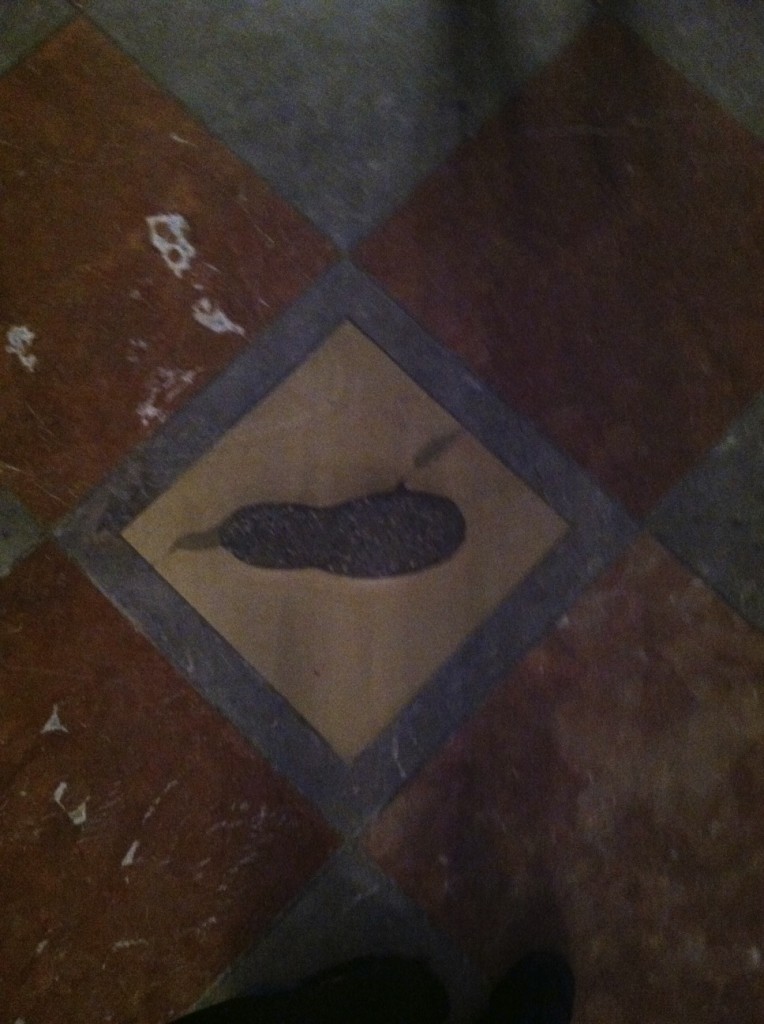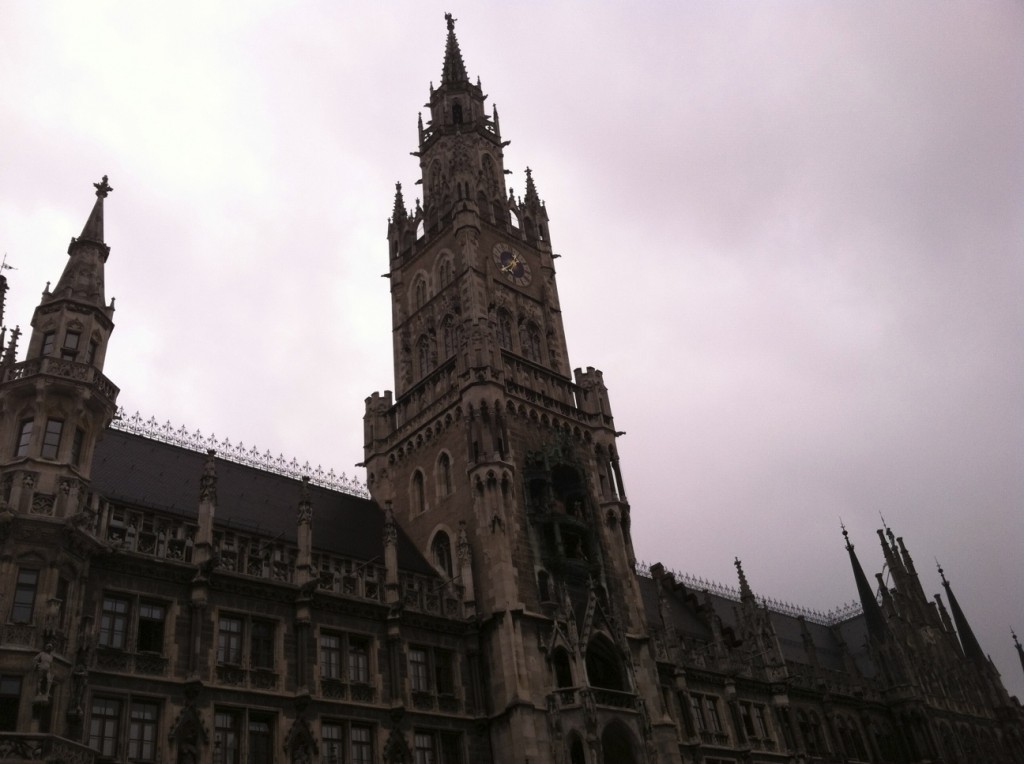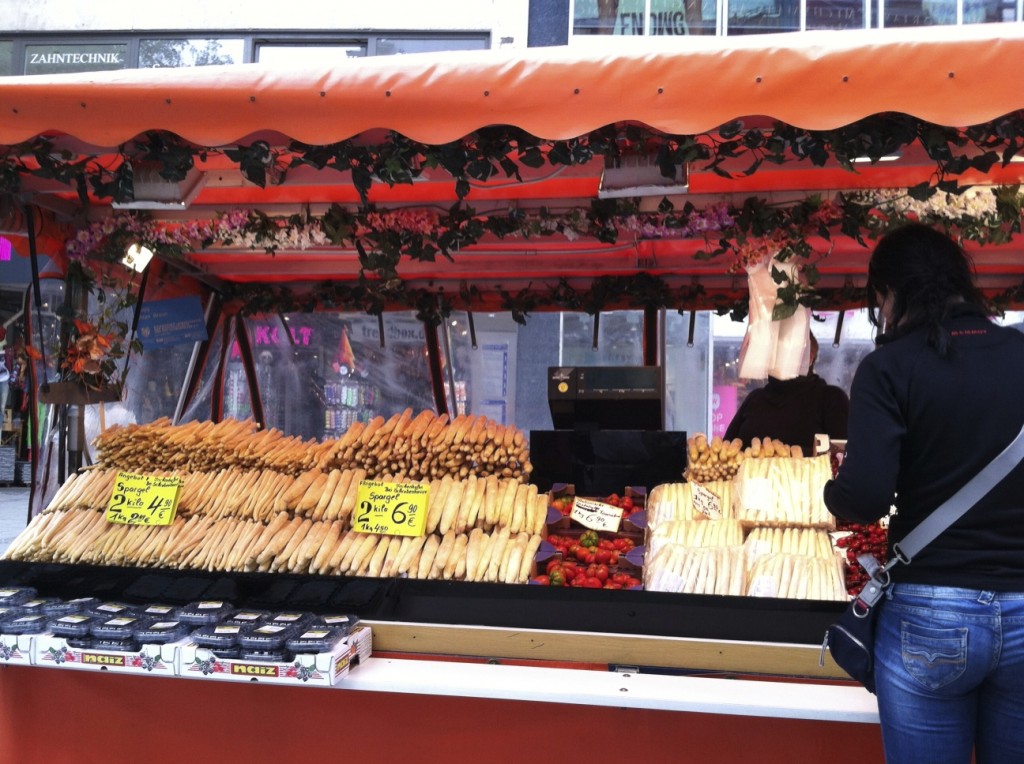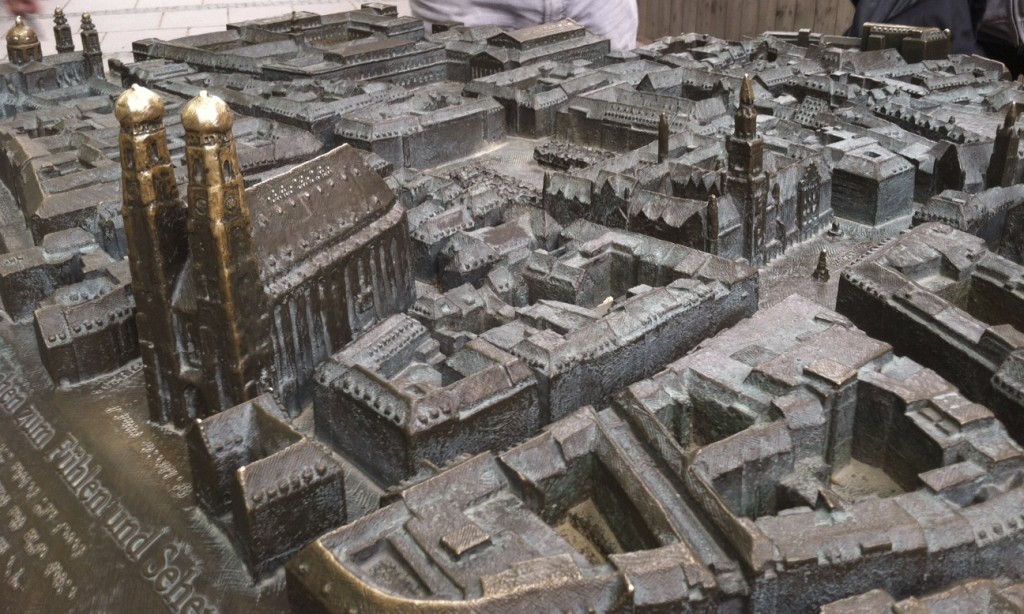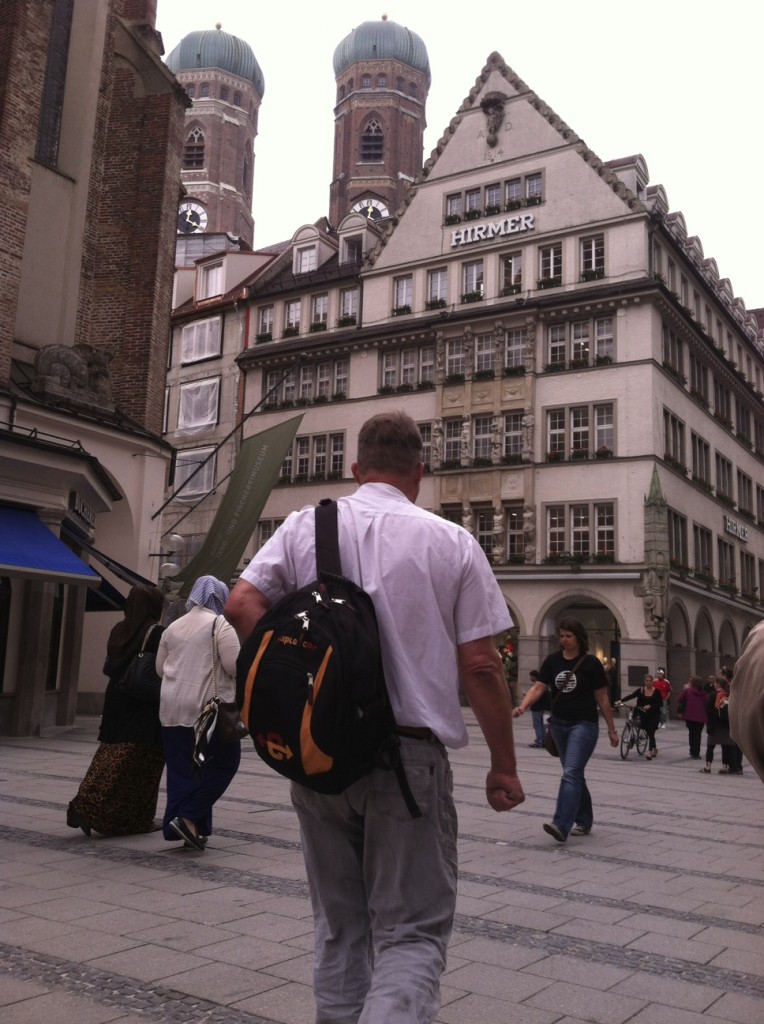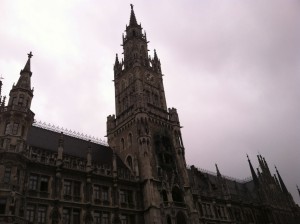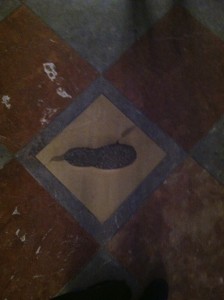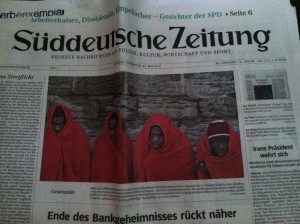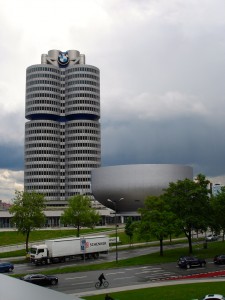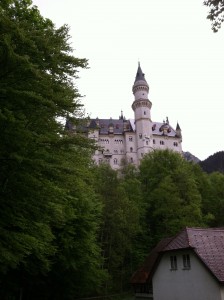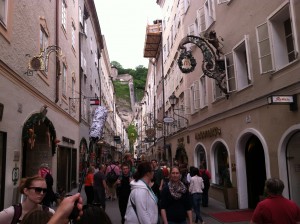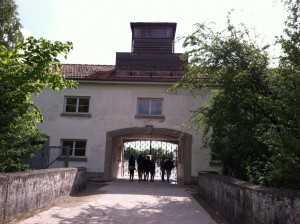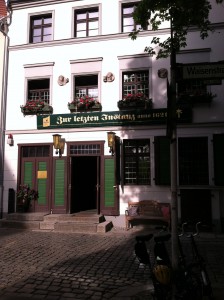Pittsburgh, meet Munich
by Carson Allwes
Point Park University’s International Media class arrived in Munich on Friday from the airport and straight into a tour of Germany’s third largest city.
Tour guide Arnoud Beck provided a bus tour from the airport to the hotel. Beck pointed out key points such as the Autobahn, the highway in Germany famous for not having a speed limit. The advisory speed limit is 130 kilometers or 81 miles per hour, and buses and trucks should travel at 80 kilometers per hour or around 60 miles per hour, according to the highway’s website.
Old and new buildings, including Munich’s soccer stadium, flashed by the bus windows as the bus took the group to its hotel. The hotel, Europäischer Hof, is in the center of Munich, near Marienplatz. And it was very close to the main train station, which the group used a number of times for visits.
Henry the Lion founded Marienplatz in 1158. Today it is a shopping center. Downtown Marienplatz was filled with people browsing shops, eating in cafés, visiting street vendors and enjoying outdoor street music.
Vendors set up along the streets with their carts full of fruits, vegetables and white spargel, or asparagus, which was in season. Their customers were dressed in everything from lederhosen to everyday apparel.
Marienplatz has several key points that depict Munich. Beck showed the group a couple of churches, including Bürgersaalkirche and the Frauenkirche.
Bürgersaalkirche is between two buildings and almost blends into the scenery. The church has a museum for the Rev. Rupert Mayer SJ. He was a Jesuit priest who was a chaplain in World War I, losing a leg in a grenade attack. During World War II he preached against the Nazis and was placed in “protective custody” and later sent to a concentration camp by the Nazis. He returned to a hero’s welcome from Catholics and others after the war ended and died of a stroke in November 1945. Pope John Paul II beautified him in 1987, which is a path to sainthood. The museum also displayed many other different religious statues and relics.
The Frauenkirche is the tallest building in Munich. It was decided by the city that no building should be taller than the Frauenkirche’s two towers, which are around 100 meters tall.
Beck explained why the Frauenkirche survived the war.
“The high points of the church gave the army [a marker] to bomb the city,” he said.
This saved the Frauenkirche and many other tall buildings as they were used for the military during the second war.
Inside the Frauenkirhe, Beck told the story of how the church was built. According to legend, Jörg von Halsbach needed funding in order to build the church and asked the Devil for help. The Devil would help but only if Halsbach did not put windows in the church.
Halsbach tricked the Devil by using the architecture to give the appearance of a windowless church. Devil was not fooled.
“In [the Devil’s] anger at being fooled, he [stomped] his foot and left his footprint [in the floor],” Beck said, showing it to the students.
The Frauenkirche is also the home of the archbishop. This is the church where former Pope Benedict XVI practiced as bishop before moving on to the Vatican.
Another famous piece of architecture is the Glockenspiel.
The Glockenspiel is in the center of Marienplatz, an old gothic-themed building with gargoyles and flying buttresses. The clock is in the center tower. The clock tower has two open windows with pieces that move at 11 a.m. and 5 p.m., attracting a crowd. The inner mechanics put on a show for the people in the square. The entire show lasts about 15 minutes.
Beck’s tour ended with permission to begin exploring and sampling Munich’s cafés and restaurants. The tour formed a foundation of important landmarks and history that better shaped the group’s understanding of the city over the rest of their trip.
An Overview of Süddeutsche Zeitung
by Carson Allwes
Point Park International Media class’ final media visit was to Süddeutsche Zeitung, one of the largest quality newspapers in Germany.
Süddeutsche Zeitung was the first free national paper in Germany. It reaches about one and half million people and is a Monday to Saturday paper. It depends partly on subscribers and single copies; about 84 percent of total sales come from this. One subscriber pays about 51.60 euro per month.
Having this revenue helps it not accept any government funds, which is true for some other German media. “There is no political pressure…no pressure from the government what to write,” said Michael Stengl, the product manager of advertisements.
Stengl started with a video of what a day is like at Süddeutsche Zeitung. Stengl translated the video and introduced the group to the newspaper company.
A day at Süddeutsche Zeitung starts at 4 in morning and the paper starts printing at 6 o’clock in the evening. There are usually three editions of the paper before the final copy.
“There are a few similarities between The New York Times and Süddeutsche Zeitung,” Stengl said.
There are regionals papers, free advertising papers, business information and specialized medicial and technology papers under the Süddeutsche Zeitung brand. The national edition of Süddetusche Zeitung, often abbreviated simply as “SZ,” contains four feature sections in economy, culture, sports, and politics. Issues printed for Munich and its closest municipalities will normally contain a local news insert.
Süddeutsche Zeitung has published an eight-page insert of The New York Times articles since 2004; this is known as The New York Times International Weekly and it is in English.
In 2000, advertising problems became a concern for the company. Süddeutsche Zeitung Library was created to response to provide revenue, which is a book group that has 50 works in the collection. Consumer can either buy the complete set or the individual book. The library venture was a huge success, Stengl said.
Süddeutsche Zeitung sold 80,000 complete sets and 12 million books total. Now, the company is expanding its medium to CDs and DVDs.
Süddeutsche Zeitung was located in Marienplatz for about six decades until the economy collapsed, Stengl said, and it resulted in a major staff reduction and need for a new direction to survive. A new building was constructed on the outskirts of Munich in 2007, and at the time was the most advanced and ecofriendly building in Germany.
Süddeutsche Zeitung is a unique newspaper because it has its own major production process plant, Stengl said, which is home to a state-of-the-art printing press. It is in charge of printing and packaging enough papers to supply SZ’s massive circulation as well as single copies. Along with Süddeutsche Zeitung’s own audience to satisfy, there are 13 other newspapers in Munich printed at SZ’s plant that exist outside of Süddeutsche Zeitung brand.
Stengl emphasized the quality of the paper and the need to be innovative to keep subscribers and to attract new readers.
“We focus on the quality of the paper,” Stengl said. “[And] on the quality of our products.”
He also said the editor in chief wants to be sure “not to bore” the professor or businessman but also to “educate the common people.”
Several other staff members and editors addressed the group, journalist Viola Schenz and Barbara Vorsamer, subchief editor. They reviewed the online process and the journalistic process the newspaper follows.
Vorsamer noted that the paper’s has “one of the most-read and unique news sites in Germany.” She said, “We were not the first, but we have one the most highly regarded sites in Germany.”
The staff posts all of what’s in the print edition, but some content is exclusively online. The newspaper uses real-time tracking for the site, and she noted that the peak time is noon to 1 p.m., or lunchtime.
Both Vorsamer and Schenz stressed that he most important issue for Süddeutsche Zeitung was the quality of its paper to reflect the brand of all its products for the masses. The paper has worked tirelessly to deliver the best news possible to their subscribers and have been rewarded immensely for their efforts, they said. Their innovation in printing, quality journalism, business and advertising have earned them significant recognition and accolades.
Day 11: Last day in Munich
Day 11
Today is the last full day in Munich. We have a full day planned. First in order is Ketchum Pleon. Again it was one of those days in Munich except this time, it was a continual rain.
We took public transportation to get to Ketchum Pleon. Ketchum Pleon is an Ad and PR company that originally started in Pittsburgh and ironically it is the company’s 90th birthday. It was impressive how the company plans its packages for a company’s campaign. The presentation provided tips on how to cater and support a product for a company. One of the major things that I have picked up on German media is how organized and thought out every step is in any project. It is seriously impressive to be that well organized and it really shows in the final product.
After Ketchum Pleon, we raced back to the hotel for a quick lunch. I had been using my crutches and switched to the wheelchair, since I was told it was going to be a lot of standing and walking for the second media tour.
The second media trip was to Süddeutsche Zeitung. Süddeutsche Zeitung is one of the most successful newspapers in Germany. This company was especially impressive because of how much thought and innovation the company put into keeping the readership and advertising in print.
For advertising, Süddeutsche Zeitung really pushed the limits by creating scented, perforated, flexible or UV coated ads. It was amazing each time Mr. Stengl brought out a different ad. It was something that you simple don’t see in the US. Mr. Stengl also gave up a tour of the printing press, it is one of the best printing presses in the Germany. It was interesting seeing the different steps needed in order to create a paper. According Mr. Stengl each paper gets at least updated four times before the final copy. It certainly takes a lot of work to create a newspaper.
Süddeutsche Zeitung media trip was followed by the goodbye dinner at Munich Ratskeller. It is Johnie’s birthday and we surprised her with a card and cake. We also thanked Arnoud and Helen. The food was fabulous.
It is sad that the trip has finally run its course. Much has happened on this trip. For one thing, I never imagined I would spend my first time in Europe in a hospital and using crutches or a wheelchair. This trip has taught me more than just the media outlets in Germany, but has taught me in life as well. Sure it wasn’t ideal to be traveling via crutches or explore Berlin and Munich with them. The point I learned was to enjoy what you have and to appreciate the things you can do. Now this doesn’t always mean you get to do what you want to do, but you live and you learn.
Tomorrow is the flight home!
Carson
Day 10 BMW
Day 10
The weather in Germany is interesting. One moment it is clear blue skies and the next thing you know you under dark rain clouds being pommeled with cold rain. That’s how the day started on the way to BMW for the media trip.
Looking outside the window, the skies were bright blue, the sun shining and the temperature nice and warm. I had walked the past two days and figured I should take the wheelchair, since today was all walking. The weather, judging by the appearance, looked like it was going to stay nice – wrong.
While on the journey to BMW, we took the underground system, which isn’t handicap accessible for getting off and on the trains. Alexa was helping me maneuver through the people and Arnoud was lifting the chair and me off and on the train. Alexa had handed me her purse for safekeeping. The unthinkable happened next, while Arnoud was getting me on the train, her purse fell off the train and on to the tracks! (I feel terrible). The doors closed (with all of us on board) and Alexa’s bag still on the tracks as we speeded away. We all got off at the next stop and Alexa and Arnoud doubled back to get her purse.
From what we were told, when we regrouped, Arnoud jumped on to the tracks and rescued Alexa’s purse! Talk about being a modern day hero. All of this happened under ten or so minutes.
We continued to BMW. Wow. BMW is an amazing company, and extremely involved in the next up coming thing. The media and advertising strategies they use are very well planned and thought through. At BMW, they showed us their plan for their new lines of vehicles: BMWi. These are cars are electric based and for city people to provide better mobility around the city.
After the meeting we went to the museum. Now I did not realize this at the time, but BMW owns the Mini series (Mini Coopers), which happens to be my all time favorite car in the entire world. So during the tour, we saw BMW’s top cars, Rolls Royce, and Mini Coopers. The tour also included a historical portion on the company.
Then at the end of the tour, we looked out the window. Pitch black clouds, strong gusts of winds, lighting flashing in the sky and torrential down pour, and since I thought it was going to be nice – no raincoat or umbrella for Carson. In fact, I wasn’t the only one who thought the weather was going to be nice, and a couple of us didn’t even have a coat.
It’s safe to say most of us got wet on the way back to the metro stop. After we got back to the hotel, we had free time. Some of went shopping; I decided to relax as we are planning on going to the Hopfbräuhaus for dinner.
Tomorrow the last full day in Munich!
Carson
Day 9 Nueschwanstein Castle
Day 9
We went to Nueschwanstein Castle!!! This castle is basically where Disney got his idea for Cinderella’s castle. We took the train ride to get there again. Taking the train is awesome because you get to see the countryside, but also the real German life outside of a major town or city.
It took two hours to get there plus a bus ride. However there is also a vertical hike up the mountain and with my foot it wasn’t possible for me to do. Instead, I took a horse and carriage to the castle…sounds magical and oh so wonderful right? Not really, it a tourist thing in the town. On the ride up to the castle I went with Johnie. Unfortunately there was a bunch of young kids – so a lot of crying on the way up, but it was worth it.
The castle is amazing – especially from the outside. You think that inside would be magnificent too, but the castle was never finished. Lugwig II died under mysterious circumstances and the Nueschwanstein castle construction was put to an end at his death. Only a few rooms are completed, which the tour showed parts of. The finished parts of the castle were amazing- for lack of a better word. We weren’t allowed to take photos inside the castle, but the memories of this place will last. There was so much artwork and detail put into a single room that it just sticks with you once you have seen it.
The view from the castle was just as awesome. (We were allowed to take photos from the castle of the outside). You can see the town down below or to the Alps. The castle is basically on a smaller hilltop that brings you real close. I had originally imagined the Alps to be like the Appalachian Mountains – not true. Unlike the Appalachians, the Alps are mostly rocks and peaks and sporadic trees and some how this mountain range is simply breathtaking.
After coming out of the castle we were given a little bit of free time. I had to stop and put on my jacket because of the rain. I have a Brita water bottle that I hook on to my crutches with a hair-tie. In the process of getting my rain coat on properly, my water bottle promptly fell off my crutch and down the side of the mountain. It’s safe to say I will never get that water bottle back. The funny thing is – that water bottle hasn’t, up until that moment, ever fallen off my crutch. So in a weird and disappointing way I left a piece of myself with the Nueschwanstein castle.
With a heavy heart I left the castle and my water bottle for the horse ride down. This time was more pleasant as there were no screaming children on board. After that it was a bus and train ride back to Munich.
Today was amazing and it makes me want to see more castles… and invest in a new water bottle.
Carson
Day 8 Day trip to Salzburg, Austria!
Day 8
Today we left Germany for Salzburg, Austria. This is the day I was waiting for! We traveled via train – it was amazing. The train took us by the Swiss Alps, which is by far the most impressive sight I have seen on this trip.
The trip to Austria is a day trip and it took about an hour and half to get there. It was a cloudy day that promised rain later. As soon as we arrived we went on a quick tour to see the main streets and sights of Salzburg. Fun facts about Salzburg that I didn’t know before is that this were the Sound of Music was filmed and the Von Trapp family was real. Part of the tour took us through the gardens where Julie Andrews and the children sing “Do Re Mi.”
The tour also included where Mozart grew up and lived for a portion of his life. Salzburg was what I imagined Europe to be like: filled with people and shops on the side. It was an amazing day and it was a shame that we only had a day to get a fill of the sights. After the tour we had free time, where it started to rain and with my leg I had to take it a bit slow, but I ended up finding some pretty cool things with Alexa. In fact we found a spout in the shape of a gargoyle that shot fresh Alp water for drinking.
After meandering the cobblestone roads, we met up with the group for dinner at a small restaurant called Restaurant zum Eulenspiegels. The food was great and very filling – I also got a dessert of apple strudel (yum!!). The train ride back to Munich was the perfect place to catch some sleep.
Today was exhausting, but well worth the trip! Tomorrow we are seeing a castle!
Carson
Day 7 Dachau
Day 7
Today we went to Dachau. It was one of those days where the sun is shinning and the birds are singing, which was at odds to the gravity of where we were. Dachau is a concentration camp that was used during the 40s.
We took the S-bahn and a bus to get there. At first, the town seems very quaint and pleasant. It would be hard to imagine that a concentration camp was ever there. To get to the entrance of Dachau you walk down this path with bright green trees. It interesting how you imagine things to be, in this instance I imagine everything to be dead and no life because of the horrors of what happened in that small location. Despite this, life moves on and plants grow and the birds sing.
The entrance to the camp is this massive stone archway with a wrought iron gate. In the door the words: Arbeit Macht Frei, which means, “Labor makes you free.” The camp is barren, except for the trees lining the road, the one main building and two of the barracks that are reproductions. To be honest the camp reminded me of the Hunger Game set, and in all seriousness it was simply depressing walking on gravel where so many were starved and most likely died on.
Arnoud acted as tour guide and showed us the camp. One of the scariest moments was when he took us through the crematorium. Arnoud took us through as if it was then, we walked through each room – there aren’t words to describe what it felt like. Even years later there is a solemnness that incases the camp. Arnoud said two things that stuck with me during the tour. The first was at the beginning. Being a journalistic group, one of us asked if it was allowed to take pictures. He responded that you MUST take picture. This way you can spread the message. The second was from a statue that stated “Denket Daran wie wir Hier Starben,” which he translated to “Remember how we died here.” By the time we left Dachau, it was a heavy feeling.
The rest day was free time. I decided to forgo crutches and wheelchair for Dachau and probably over did it a bit. So I used the wheelchair for the rest of the day, since tomorrow we are going to Austria! (I’m going to use crutches tomorrow). I went with a group who were going shopping. I really wanted to see the Glockenspiel ring at 5 p.m. so I joined along a.k.a they all took turns pushing me in the wheelchair, which I’m beyond grateful that they included me.
Today was a powerful day filled many emotions and hopefully tomorrow in Austria will be a lighter day.
Carson
Day 6 Goodbye Berlin, Hello Munich
Day 6
We have left Berlin and are now in Munich! It is very different from Berlin. Munich has more people and feels more crowded.
The day started at 4:30 a.m. to get to the airport on time. We said our goodbyes to Lorena at the airport and boarded the flight to Munich at 8 a.m. This time we did not have any problems with the plane or our luggage.
It was been an exhausting week and as soon as I was in my seat for the flight I was asleep. It was a wonderful flight. After the luggage was gathered we met with our new tour guide, Arnoud.
Arnoud had a surprise for me – a wheelchair. Today is my last day on crutches, so I was surprised, but I took the offer to use the wheelchair. From the airport we traveled on the famous autobahn. The autobahn is the highway with no speed limit – it was pretty cool. Fun fact about the autobahn, buses and trucks do have a speed limit – so no fast driving for us.
The hotel we are staying at feels like a Holiday Inn and not modern like the place we stayed at in Berlin. After dropping off our suitcases we went on a quick tour of the area around. With me in the wheelchair and Alexa pushing me (thanks so much, Alexa!!). We journeyed to the main street in Munich.
First, there are more older building here than Berlin. Second, everything is much closer here than Berlin. I feel I will be able to see more here and do more here since everything is closer.
After the tour, we split up to eat lunch. We went with another traditional place called Weisses Brauhaus to get German food. I got a salad with a sort of pork dish and of course some beer.
A media/ culture visits was next at Munich Tourism Office with Isabella Schopp. Ms. Schopp told us about the value of tourism in Munich and some facts from tourism. In Munich, there are times when there are more tourists than the locals. There are events such as Oktoberfest that draw in tourist.
We then had free time after the media event. I used that time to sleep. It was wonderful – it was a perfect three-hour nap that left me well rested for dinner at 7:30 p.m. Our welcome dinner to Munich was at Café am Marineplatz. It was an interesting dinner. It was traditional German food again except this time there was white sausage.
Tomorrow is my first day that I’m going to forgo both wheelchair and crutches since my fall. I’m being optimistic in the fact that I’ll make it through the day.
Looking forward to a wheelchair/crutches free day!
Carson
Day five: Last day in Berlin
Day five:
Today is the last day in Berlin and it’s sad to be leaving. I wish I was able to have spent more time exploring the city, but my foot didn’t make it possible. However I can say that taking the taxi to get to different places did show me a lot too.
The media trip for today was Axel Springer. Axel Springer is the largest multimedia agency in Europe. It is impressive what this company does. We met with Rudolf Porsche, Marc Jungnickel, and students from Axel Springer Akademie.
Rudolf Porsche was in charge of the students. His passion for the next generation of journalists was evident from how he changed the schedule so we could talk to students from the program and get lunch with them. It was amazing to talk to the students and get to pick each other’s brains.
Marc Jungnickel was in charge of the web TV for The Bild. He explained how even though the Bild is a print publication, they are able to skirt the line with video on the website because it is used to enhance the articles. In Germany, organizations need licenses in order to broadcast. So it was interesting in how Jungnickel explain the legal issue of the TV web section of the Bild.
Since it was the last day in Berlin we had a group dinner at Zur Letzten Instanz. The food was great. You get such large portions in Germany that it’s hard to finish your plate. The restaurant was in such a cute place that was nestled behind the main road.
After dinner, we went back to the hotel to pack for tomorrow. We have to get up early – 4:30 a.m for the flight. Everyone went out for ice cream and Alexa brought me some back … slightly melted but good. We will also be parting with Lorena. I’m going to miss her. With out her, it wouldn’t have nearly been as easy to get through the German hospital.
I’m calling an early night. I’m sad to be leaving Berlin, but excited to go to Munich!
Carson
